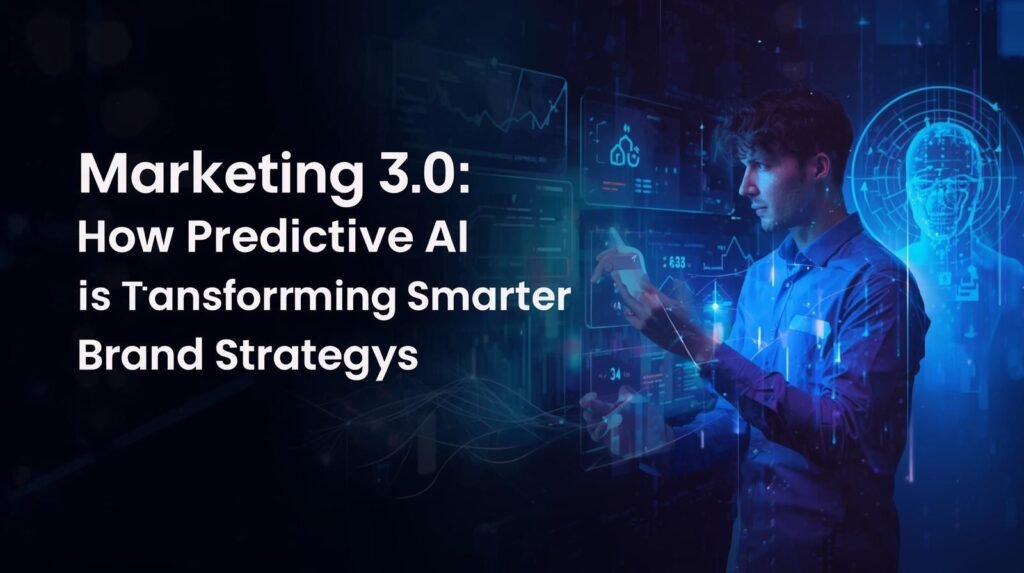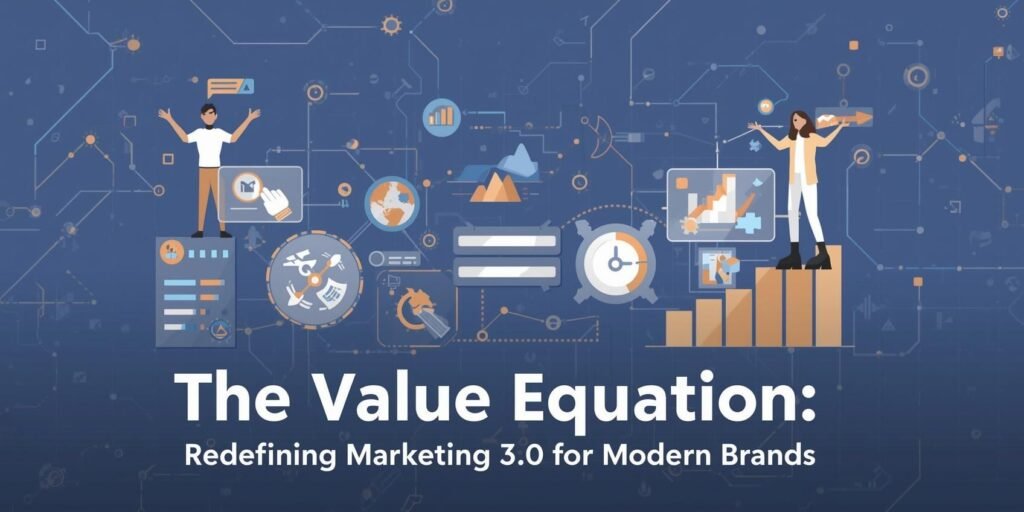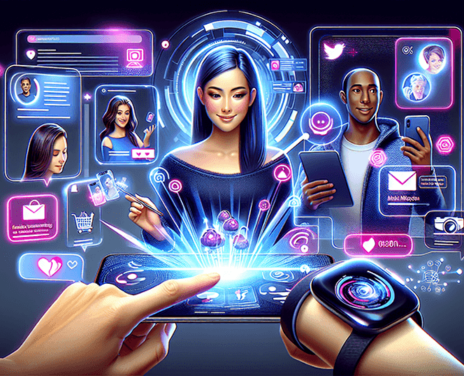
In the evolving landscape of marketing, a new paradigm is emerging—Marketing 3.0, where brands no longer push messages, but engage in a living, adaptive conversation with audiences. At its center lies AI in digital marketing—not as a gimmick or add-on, but as a core strategic engine. From predictive marketing analytics to AI content automation, and powered by marketing personalization tools and intelligent ad optimization, this new mode of marketing is capable of not just reacting, but anticipating, shaping, and evolving in real time. At AixCircle, we see Marketing 3.0 as the next frontier in brand strategy, where AI augments creativity, precision, and depth in every campaign.
In this article, we unpack how brands are leveraging AI in digital marketing to forecast trends, decode behavior, automate content, and optimize media. We explore core pillars, use cases, challenges, and a roadmap for brand leaders to ride this transformation rather than be disrupted by it.
The Shift to Marketing 3.0: From Push to Predict, from Static to Adaptive
Traditionally, marketing has followed a linear path: research, plan, execute, measure. In that model, marketers crafted campaigns months in advance and hoped for resonance. But consumer behavior, media dynamics, and competitive pressures now shift too quickly for static plans. That is where AI in digital marketing and predictive marketing analytics come in, enabling brands to become anticipatory engines rather than reactive machines.
In Marketing 3.0, brands move beyond segmentation based on demographic snapshots. Instead, real-time signals—click patterns, browsing paths, social behavior, sentiment shifts—feed into AI systems that dynamically adjust messaging, creative, channel allocation, and even product positioning. With marketing personalization tools, brands can deploy segment-of-one strategies: messaging that evolves with each user’s micro-journey.
At its heart, Marketing 3.0 shifts brand strategy from “we broadcast, customers respond” to “we sense, adapt, co-create.” AI content automation ensures that creative assets scale and adapt; intelligent ad optimization ensures each media dollar is spent where it resonates most.
Pillars of Marketing 3.0 Powered by AI
To understand how Marketing 3.0 operates, let’s break down its key pillars—each powered by AI in digital marketing and tied to predictive marketing analytics, AI content automation, marketing personalization tools, and intelligent ad optimization.
1. Predictive Insights & Trend Forecasting
At the core is predictive marketing analytics: using machine learning models to ingest vast quantities of first-party data, behavioral signals, external indicators (macro, social, economic), and unstructured inputs (reviews, sentiment) to forecast shifts before they fully manifest. These forecasts inform what products to emphasize, which audiences to prioritize, and when to deploy campaigns.
For example, a retail brand might detect through predictive signals that a city will see a surge in demand for athleisure wear in two weeks, and shift ad spend, stock, and creative accordingly. With AI in digital marketing, marketers can anticipate demand before mainstream indicators catch up.
2. Adaptive Content at Scale (AI Content Automation)
One of the major constraints in modern marketing is scale: how do you deliver customized content to thousands or millions of micro-segments? Enter AI content automation—the capability to generate, adapt, and personalize content dynamically across formats (text, visuals, video, email) based on signals and models.
In Marketing 3.0, creative templates are augmented by AI engines that adapt headlines, visuals, CTAs, language tone, and even layout based on the audience’s preferences or predicted behavior. Content becomes living, not static—a blend of human direction and AI generation.
3. Hyper-Personalization & Micro-Journeys
Marketing personalization tools become indispensable in Marketing 3.0. Rather than rely on broad segments, these tools leverage AI to craft individualized journeys. At every touchpoint—website, email, in-app, social—AI decides which message, offer, or experience to show.
A user might see one ad creative in the morning, receive a personalized email midday, and find a recommendation on the site that afternoon, all orchestrated by AI. Personalization is no longer one-time; it is a continuous, evolving conversation.
4. Media Efficiency via Intelligent Ad Optimization
Media investment is a constant battleground. In Marketing 3.0, intelligent ad optimization ensures budgets go where they perform best—real time. AI models decide bid strategies, channel mix, creative combinations, and audience exposures dynamically.
Through predictive signals, optimization algorithms anticipate ad fatigue, shifting costs, and audience saturation. The system reallocates spend—pausing underperformers, scaling winners, testing new ones—and maximizes ROI.
5. Closed-Loop Learning & Feedback
In classic marketing, learning cycles were slow and manual. Marketing 3.0 is built on feedback loops. AI systems continuously ingest performance data (clicks, conversions, dwell time, sentiment) and refine models in real time. Predictions improve, content adapts, personalization evolves, and optimization becomes smarter.
This closed-loop learning is the engine of Marketing 3.0. AI in digital marketing ensures the system never grows stale: it learns, corrects, and grows more precise with every iteration.
Use Cases: How Brands Are Doing Marketing 3.0 Today
To bring these pillars to life, here are concrete use cases where AI in digital marketing and its components are already making a difference.
E-Commerce & Retail
Retailers deploy predictive marketing analytics to forecast demand surges, product interest shifts, and churn risk. They feed those forecasts into AI content automation to dynamically craft emails, site banners, and push messages.
Marketing personalization tools ensure each shopper sees products, promotions, and visuals tailored to their tastes. And intelligent ad optimization distributes media budgets across search, social, display channels based on real-time performance and predicted lift.
Subscription & SaaS Brands
Subscription brands use predictive models to predict churn or upsell likelihood. AI content automation crafts retention emails, educational content, or offers automatically. Personalization tools tailor content to usage patterns, engagement scores, and customer persona. And intelligent ad optimization targets lookalike audiences predicted to convert.
Consumer Packaged Goods (CPG) & FMCG
CPG brands, historically slow to adopt dynamic marketing, are increasingly leveraging AI in digital marketing to optimize trade promotions, senses trends (via predictive marketing analytics) in regional markets, and automate creative campaigns at scale (via content automation). Intelligent ad optimization then ensures media deployment is efficient and adaptive.
Media, Entertainment & Publishing
Publishers use predictive analytics to forecast article engagement, subscription behavior, and content virality. AI content engines generate headlines, social posts, and related article suggestions. Personalization tools tailor reading experiences. Intelligent ad optimization places sponsored content or audiences where engagement is high.
Financial Services & Insurance
These sectors adopt predictive models to forecast customer life events (e.g. new home, job change, health events). AI content automation helps generate personalized policy offers or educational content. Personalization tools ensure messaging aligns with individual context, and ad optimization ensures media spend is efficient.
The Value Equation: What Marketing 3.0 Delivers

When implemented thoughtfully, Marketing 3.0 powered by AI in digital marketing can deliver significant gains across metrics:
- Higher conversion rates — because content, offers, and journey personalization align more closely with individual intent and timing.
- Better ROI on media spend — thanks to intelligent ad optimization that shifts budget dynamically to highest-yielding channels.
- Faster campaign rollout and iteration — because AI content automation reduces the drag of manual creative production.
- Improved customer retention and lifetime value — via predictive models that anticipate churn and enable timely re-engagement.
- Greater agility and adaptability — as marketing becomes a live system that senses and adjusts in real time.
- Scalability without manpower explosion — personalization at scale becomes possible without hiring armies of creative or targeting teams.
Brands that succeed with Marketing 3.0 often see two to five times uplift in ROI over legacy marketing approaches, over time. The compounding power of model improvements, creative adaptability, and media efficiency becomes a significant moat.
Implementation Roadmap: How to Build Marketing 3.0 at AixCircle
At AixCircle, we advise clients to adopt a phased, careful approach when embedding AI in digital marketing into brand strategies.
Phase 1: Strategy, Use Case Prioritization & Data Foundations
- Begin with clarity: define strategic goals (growth, retention, margins) and key performance indicators.
- Audit existing data: customer profiles, behavioral logs, campaign performance, content assets.
- Identify high-impact use cases (e.g. churn prediction, dynamic creative, audience scoring) and prioritize based on ease and value.
- Build data pipelines and integrate siloed systems (CRM, analytics platforms, ad systems) to create unified customer profiles.
Phase 2: Pilot & Experiment
- Select a manageable segment—say, a region or product line—and develop predictive models (e.g. churn, propensity, segmentation).
- Deploy AI content automation for a limited set of creative templates.
- Use marketing personalization tools to deliver variant messaging on web, email, or app.
- Run intelligent ad optimization experiments with dynamic bidding and creative rotation.
- Gather performance, analyze lift, refine the model, and monitor feedback loops.
Phase 3: Scale & Orchestrate
- Modularize each component (prediction engine, content generator, personalization decision engine, ad optimizer) into interoperable modules.
- Expand to more audiences, geographies, and campaign types.
- Integrate additional signals (e.g. external macro, sentiment, competitor data) to enrich predictive marketing analytics.
- Continually monitor and update models, incorporate human overrides, and maintain explainability.
- Introduce governance, auditing, model monitoring, and failure safeguards.
Phase 4: Cultural & Organizational Change
- Upskill marketing, creative, and data teams in AI literacy.
- Establish a marketing AI Center of Excellence to centralize best practices, oversight, and resource sharing.
- Encourage an experimentation mindset: fast fails, iterative improvements, model transparency.
- Embed feedback loops so that creative and media teams are in constant dialogue with AI outputs.
Phase 5: Innovation & Next Gen Capabilities
- Introduce generative AI and LLMs to ingest market signals and propose strategy-level insights.
- Explore reinforcement learning models that dynamically adjust creative and media in a control loop.
- Extend personalization beyond marketing—from product features, pricing, packaging to loyalty programming.
- Integrate cross-channel orchestration to unify experiences across offline, in-store, metaverse, or live events.
Through this roadmap, brands guided by AixCircle can evolve from sporadic AI experiments to full Marketing 3.0 maturity.
Challenges, Risks & Mitigations
Marketing 3.0 is compelling, but heavy with complexity. Here are the challenges we often see and how to address them:
- Data quality and silos
Predictive models require clean, integrated data. Many organizations have lagging or fragmented systems. Mitigation: invest in master data management and unified customer profiles. - Model drift and stale predictions
Consumer behavior shifts constantly. Mitigation: implement model monitoring, retraining pipelines, and fallback rules if predictions degrade. - Creative constraints & oversimplification
AI-generated content can feel generic or repetitive. Mitigation: keep humans in the loop as supervisors, editors, and strategic curators. - Black box decisions and lack of transparency
Marketing teams may distrust AI without visibility. Mitigation: build explainability, decision logs, and human override paths. - Regulatory, privacy & consent
Personalization and predictive targeting raise privacy concerns (GDPR, CCPA). Mitigation: rigorous consent mechanisms, anonymization, and privacy-first design. - Organizational resistance and change inertia
Teams may resist ceding control. Mitigation: education, stakeholder alignment, quick wins, and transparency. - Cost, complexity & initial investment
AI platforms, infrastructure, and talent can be expensive. Mitigation: start small, prove value, reinvest gains. - Over-optimization and tunnel vision
Focusing only on short-term click metrics can erode brand equity or lead to creative fatigue. Mitigation: calibrate AI optimization with brand guardrails, identity constraints, and long-term metrics.
Marketing 3.0 in the Future: What’s Next
Looking ahead, several trends will push Marketing 3.0 even further:
- Generative Strategy Engines / AI strategists
Not just content automation, but systems that propose campaign strategy, messaging themes, or brand narratives based on signals and simulation. - Self-optimizing media ecosystems
Whole campaigns that auto-adjust creative, budget, channel mix, and cadence with minimal human intervention. - Cross-domain personalization
Personalization will go beyond ads and content—into product design, pricing, bundling, packaging, and loyalty offers. - Emotion & sentiment AI
Deeper modeling of emotional response, tone, and brand affinity to guide message resonance in real time. - Ethical & value-based AI marcom
As AI shapes brand voice, we will see more AI-based alignment with brand values, transparency, and consumer trust. - Human + AI creative co-creation
Not replacing creatives but equipping them with AI ideation, sketching, and storytelling co-pilots. - Integration with XR, AR, VR, voice
Personalized experiences in immersive environments, dynamically shaped by AI.
The frontier is not just smarter ads, but smarter brands—living, evolving, conversational systems that align intimately with human behavior.
Why AixCircle Is Your Ideal Partner in Marketing 3.0
At AixCircle, we combine marketing domain expertise, AI engineering, and strategic vision to help brands make this leap. Here’s how we add value:
- Strategic Alignment
We start by translating brand goals, customer insights, and competitive context into AI-enabled marketing strategies. - Architecture & Integration
We design scalable, modular systems connecting data, prediction engines, content generators, personalization, media optimization. - Model Building & AI Ops
Our data scientists build bespoke predictive marketing analytics models and automate content pipelines. - Creative + Automation Fusion
We help creative teams collaborate with AI systems. We design guardrails, frameworks, and human-AI workflows. - Governance & Explainability
We build transparency, versioning, human override, and compliance into every layer. - Training & Change Leadership
We upskill your teams, embed a culture of experimentation, and institutionalize AI practices. - Scaling & Growth
Once pilots succeed, we help you scale Marketing 3.0 across geographies, channels, and product lines.
With AixCircle as your partner, Marketing 3.0 becomes less a lofty vision and more a guided, pragmatic evolution.
Conclusion
Marketing 3.0 ushers in a new era of brand strategy—one where AI in digital marketing is fundamental, not optional. Through predictive marketing analytics, AI content automation, marketing personalization tools, and intelligent ad optimization, brands can move from static campaigns to living, adaptive experiences.
The path is not without challenges: data quality, model drift, creative integration, privacy, and organizational change all demand care. But with a phased roadmap and strong partner support, brands can navigate these complexities and emerge more agile, more resonant, and more competitive.
At AixCircle, we believe the future of marketing is not broadcasting to consumers—but conversing with them, evolving with them, and co-creating value in real time. If you’re ready to bring Marketing 3.0 into your brand strategy, we’re here to guide you—every step, every campaign, every signal.

